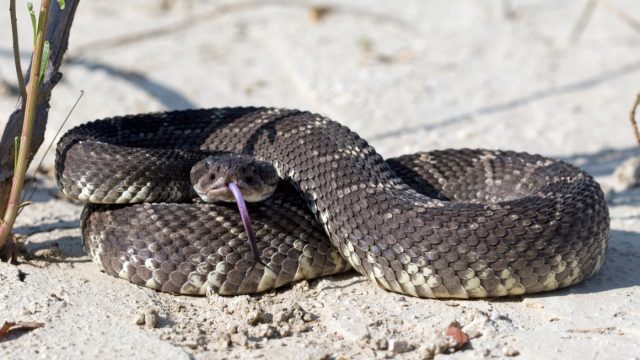Officials Issue Rare Winter Rattlesnake Warning—How to Stay Safe

You might think your only chance of encountering a snake is in the brighter spring and summer months. But don’t get too comfortable. While it’s true that you’re less likely to see a snake in the winter, climate shifts mean more and more reports of these slithery creatures popping up year-round—especially in certain regions. In fact, Texas just issued a rare winter rattlesnake warning.
RELATED: 17-Year-Old Bitten by Rattlesnake in His Home—Where It Was Hiding.
On Dec. 18, workers with the Texas Parks and Wildlife Department posted about rattlesnakes on the agency’s official Galveston Island State Park Facebook page. “Snakes like visiting the beach for the holidays too,” the officials wrote in their post.
Like most reptiles, rattlesnakes are ectothermic, or cold-blooded, according to the National Wildlife Federation (NWF).
“Ectotherms cannot regulate their body temperatures like warm-blooded animals. Instead they rely on their surroundings to provide heat, which means they can’t be active in cold weather,” the NWF explains on its website. “To keep from freezing, rattlesnakes congregate in dens and form swarming balls with their bodies.”
But one of the hiding places these cold-blood creatures use in the winter may come as a surprise: In their Facebook post, the Texas Parks and Wildlife Department revealed that these snakes will often leave their nests and burrows in order to seek out warmth from beach sand during this time.
“The sand dunes at Galveston Island State Park make the perfect home for rattlesnakes: close to warm sand, good hunting grounds, and are protected from humans,” the officials explained.
RELATED: 6 Top Signs There Are Snakes in Your Yard.
In general, cold weather does not preclude run-ins with snakes, who don’t behave the way that many other animals do when the temperature drops.
As Nick Durieu from Senate Termite & Pest Control previously told Best Life, snakes don’t hibernate during the winter. Instead, they “enter a state known as brumation,” which is similar to hibernation—except “snakes don’t sleep throughout the entire season,” according to Durieu.
“Snakes can actually wake up and forage for food or water, especially if temperatures rise, even for just a few days,” he warned. With more and more unseasonably warm days throughout winter, your chances of a snake encounter go up.
So, what should you do to stay safe if you happen to see a rattlesnake this winter?
“Don’t panic, leave it be, stay at least five feet away from the snake, and alert park staff,” the Texas Parks and Wildlife Department advised in its recent warning.
RELATED: For more up-to-date information, sign up for our daily newsletter.